Agronomy Update
Jun 09, 2025
Herbicide Resistance in Green Foxtail and Wild Oat
In our last newsletter, agronomist Kyle Okke discussed the importance of rotating herbicide groups and chemical families for effective control of grass weeds in small grains. This practice is essential to manage the growing problem of group 1 and 2 resistant green foxtail and wild oat. While resistance is not yet unmanageable, we are at a critical juncture. If we act now, we have the opportunity to preserve herbicide effectiveness—but if we continue down the current path, we risk losing some of our most valuable tools. It’s easy to assume that the herbicides we’ve relied on for years will continue to work—but the evidence shows otherwise.At the 2025 Wild World of Weeds conference, NDSU weed scientist Dr. Kirk Howatt presented survey data on wild oat resistance in North Dakota. His findings revealed populations that are highly resistant to Tacoma (Group 1), OpenSky (Group 2), and Everest (Group 2)— products that many growers rely on for weed control in durum. While Select remains effective in most cases, overuse will put it at risk. Crop rotation and strategic tank mixing are essential to reduce selection pressure and delay resistance.

Resistance of wild oat populations in North Dakota to common herbicides (Dr. Kirk Howatt, NDSU)
We use Select in peas, lentils and Liberty Link canola. To preserve its effectiveness and get better control, we recommend tank mixing Select with Assure II or Targa in peas and lentils. If a random wild oat plant happens to carry the mutation that conveys resistance to Select, then the Assure II/Targa will be there to kill it. In peas you could also add Beyond Xtra to increase grass control. Consider growing Round Up Ready canola in your rotation to kill resistant weeds grassy weeds (picture below).
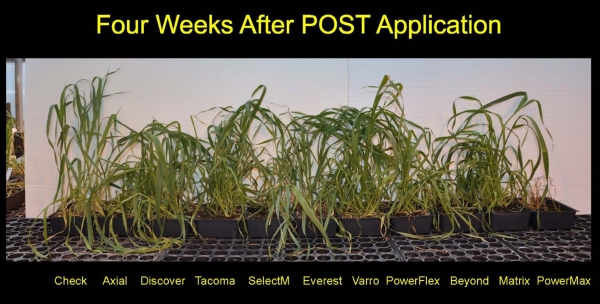
Round up is the only product tested that effectively killed this resistant wild oat (Dr. Kirk Howatt, NDSU)
When durum is grown for multiple years in a row, it is important to alternate between Group 1 and Group 2 herbicides. Repeatedly using Group 1 products selects for resistance to that group. Switching to Group 2 and continuing the same pattern then selects for weeds resistant to both groups. This scenario has already occurred in our region. Dr. Brian Jenks, NDSU weed scientist, has confirmed the presence of wild oat populations resistant to both Group 1 and Group 2 chemistries.
Managing green foxtail (pigeon grass) presents an additional complication. Many farms deal with both wild oat and green foxtail, making weed control even more challenging and expensive— especially where resistant populations are present. In 2024, Dr. Howatt reported that nearly all green foxtail samples submitted to his lab were resistant to Tacoma and Axial, both Group 1 herbicides. He has also identified green foxtail populations that are resistant to both Group 1 and Group 2 chemistries, including Tacoma, Axial, Assure II, and
Everest. Select still works in many fields, but resistant individuals are beginning to emerge, which shows that resistance to that chemistry is possible as well. Each population has its own unique resistance profile, so diversifying herbicide use is one of the best defenses. While this may increase costs, fields where resistant green foxtail has taken over don’t produce a crop and this has occurred.
Tolvera (Group 6 + 27) is an alternative to group 1 and group 2 products for green foxtail management and this will be a great tool in our rotation for kochia as well. If wild oat is an issue you will need to mix that with a group 1 or group 2 product. Wild oat is fairly easy to identify in the seedling stage due to the counterclockwise rotation of the leaf blade. It is also much taller than green foxtail at this stage in the season (2-4 inches vs. 0.5-1.5 inches) and if you dig it up you can usually find the oat shaped seed still attached (pictures below).
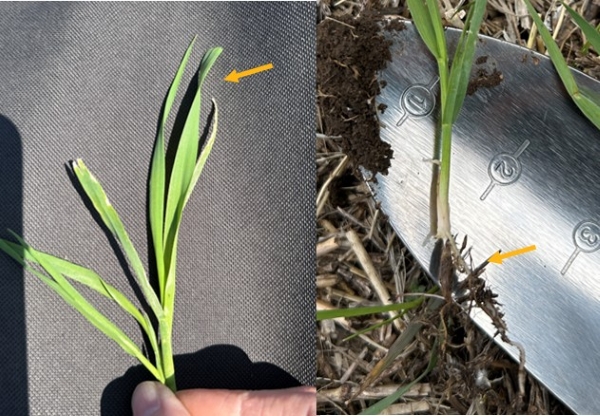
We can also start incorporating Anthem Flex (Group 15) into our fall program ahead of pulses, soybean, sunflower and spring wheat to kill resistant green foxtail as they germinate in the spring. Switching the whole farm over to Tolvera and using it year after year will guarantee that we develop resistance to the group 27 chemistry in this product, so we need to continue to be strategic if we want to successfully manage green foxtail into the future.
It takes a lot of effort to plan out your chemical rotation long term, but that is what we will need to do if we want these herbicides to continue to work. We don’t have many new products coming, nor can we guarantee new products will be affordable. Horizon Resources has invested in the FarmQA program so that we can help our customers with record keeping and planning crop and chemistry rotations. Feel free to reach out to our agronomy team to learn more.
Dr. Audrey Kalil, Agronomist/Outreach Coordinator
Yellow Wheat: Dealing with Nitrogen Loss
Our crop scouts have been noticing some yellowing or even lighter green colors in some wheat and durum fields this past week. This is almost a repeat of last spring since we had a significant amount of rainfall on crops that were already seeded.
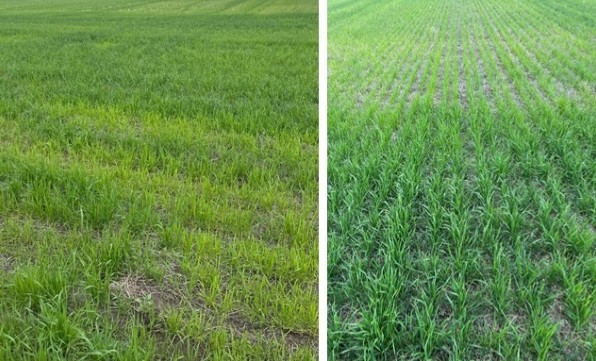
The lighter color or yellowing can be even more evident on fields that had fall applied nitrogen, since that nitrogen is more than likely in the nitrate form already and is leachable with excess moisture. If you have coarse or sandy soil texture, there is an even bigger chance of nitrogen being leached deeper than the roots of wheat plants can reach right away.
Spring applied nitrogen can also be lost with excessive moisture to denitrification. You will see this where water has been standing usually and instead of the nitrogen going downward, it can actually go up out of the soil and is lost to the atmosphere at this point.
I have seen crops grow into the nitrogen zone as the roots develop with warmer weather and they are suddenly a deeper green color as they start to uptake the nitrogen that was pushed a little lower. I have also seen where the roots are not able to catch up to the nitrogen especially in sandy soils and you will suffer yield loss and possible quality issues with your wheat crop.
Yellow fields don’t lie and there is a reason for this happening. I have seen problems with surface application of urea at the wrong time of year that created losses to the atmosphere and later with leaching. I have seen losses after significant rainfall events, and I have seen crops run out of nitrogen from the lack of nitrogen applied for the crop yield that is growing. Another issue I have seen is with people using products that just sounded too good to be true and are marketed as high efficiency fertilizer. If your nutrient levels are high enough, you might get away with this for one season, but if there is not a lot left in your soil profile to begin with, it will catch up to you. There is no such thing as high efficiency fertilizer. It does not exist and if it did, every dealer in the country would be selling them. We would all love to handle half as many tons and be able to work with smaller facilities. Nitrogen is nitrogen and phosphate is phosphate. There are no short cuts with soil fertility and if your fields are yellow after using them, you will figure it out soon enough.
If you have lost nitrogen to leaching or denitrification, or even volatilization from surface applications, now is the time to top-dress nitrogen. We can apply urea over the top of your wheat or durum field up to about the jointing stage and we can still see both yield and quality benefits. If you apply after jointing, your yield response will be limited and the only benefit you will see to added nitrogen would be a bump in your protein.
John Salvevold, CCA Agronomy Division Manger
Maximizing Grass Herbicide Performance in Pulse Crops
Spraying grasses post-emergence in pulse crops might sound straightforward, but it’s important to understand a few key nuances to ensure both crop safety and herbicide efficacy. Below are the labeled herbicides for pulse crops for grasses in-crop.
Group 1 – Mode of Action (ACCase Inhibitors):
- Clethodim – Select Max, Section Three, and generics
- Sethoxydim – Poast
- Quizalofop – Assure II, Targa
- Fluazifop – Fusilade DX
Group 2 – Mode of Action (ALS Inhibitors):
- Imazamox – Beyond Xtra
Clethodim and quizalofop are among the most used grass herbicides in pulse production. Label recommendations often list various adjuvants (NIS, AMS, COC, MSO), which can be confusing. Here’s a simplified breakdown:
- COC (Crop Oil Concentrate): Generally sufficient for most applications and provides consistent performance.
- MSO (Methylated Seed Oil): Offers improved efficacy in droughty or high Delta-T conditions.
- NIS (Nonionic Surfactant): Best used when tank-mixing with broadleaf herbicides under hot conditions on sensitive crops (e.g., field peas). Not usually recommended, but helpful in specific stress scenarios.
- AMS (Ammonium Sulfate): Adds extra “horsepower” when targeting very hard-to-kill grass species or when in spraying hot, dry conditions.
Be cautious when using Group 1 herbicides repeatedly. If you regularly use FOPs like Tacoma or Discover in durum or spring wheat, avoid quizalofop and fluazifop in your pulse crops to prevent cross- resistance. Instead, consider clethodim, a DIM, which offers an alternative chemical family within the same mode of action.
Crop growth stage matters—especially for field peas:
- Field Peas: Once peas reach the reproductive stages, clethodim can cause significant stunting and delayed blooming. This was notably problematic during the 2017 season. Delayed flowering pushes pod fill into hotter weather, reducing yield potential.
- Chickpeas and Lentils: Labels are less restrictive during flowering stages, but it’s still best practice to avoid grass herbicide applications once these crops enter reproduction.
To maximize control and minimize stress, apply grass herbicides to pulse crops early, using the appropriate adjuvants, while keeping in mind chemical family rotation and growth stage timing. The right combination ensures effective grass control without compromising crop safety.
Kyle Okke, CCA
Agile Agronomy LLC & Agronomists Happy Hour Podcast
Hear more from Kyle Okke on broadleaf control in pulse crops on the latest episode of the Growing Pulse Crops podcast.
Rolling Timing in Lentils
Most producers have already rolled their lentils this year, but I have had a few conversations about the optimal timing for rolling, and I wanted to share some relevant research conducted by Montana State University to answer this question.Field experiments were conducted in 2019, 2020 and 2021 at MSU research centers in Havre and Moccasin, as well as the main campus in Bozeman. Soils at each of the sites were classified as silty loam (Bozeman) or clay loam (Moccasin and Havre).
The study found that compared to the treatment where they didn’t roll, rolling at emergence and at the 10-leaf stage decreased yield by 5% and 8 %, respectively, on average across all the locations and study years (graph below). In contrast, rolling at planting and at the 2-4 leaf stage resulted in yields similar to the non-rolled control. If you look at the research sites individually, there were 2 out of nine sites where yield was increased by rolling at planting.
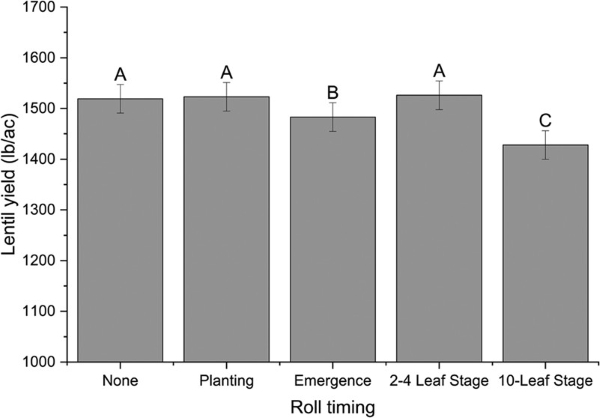
Lentil yields by rolling timing across nine site-years (2019—2021). Bars with the same letter are not statistically different (Bourgault 2023).
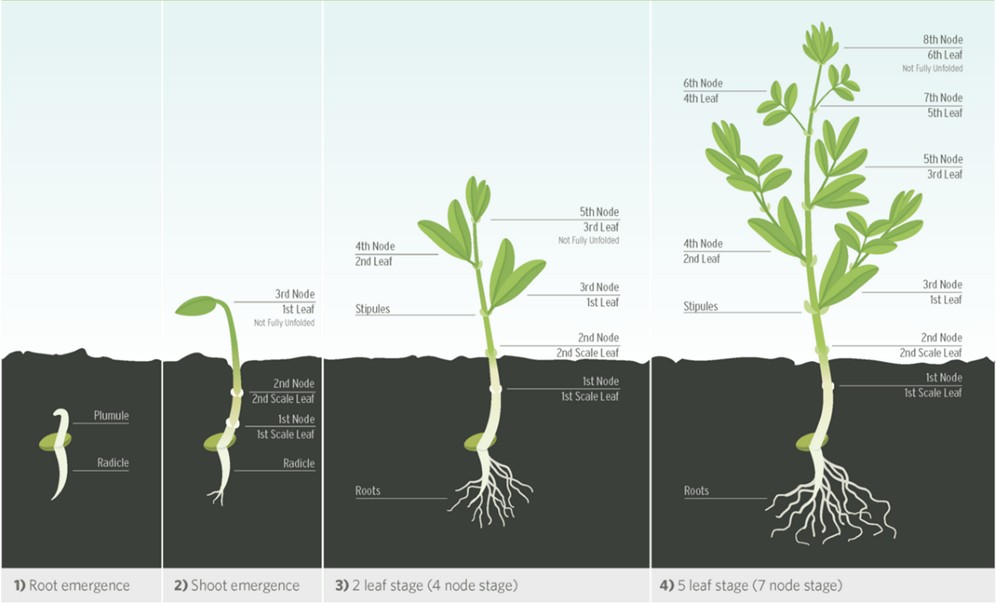
While rolling is very important to prevent combine damage during harvest, this research suggests that there may not be a yield benefit. That said, the yield reduction for late rolling or rolling at emergence was less than expected so if you get into a situation where you need to roll late it still might be worth it.
To hear more about the details of this study, listen to this episode of the Growing Pulse Crops podcast with Dr. Perry Miller.
Dr. Audrey Kalil, Agronomist/Outreach Coordinator
Fairview Agronomy Field Update: Early Summer Observations
It is slowly getting to be the time of year where producers are planning their in-crop spray so we have been out scouting fields for insects, weeds and overall crop condition.Thanks to some good rains a few weeks ago, soil moisture has been partially replenished. While we may normally associate grasshoppers with dry conditions, it’s still important to stay alert for grasshopper activity. While we haven’t seen large numbers in the fields yet, we can hear them jumping—so they’re definitely present. As we move further into the summer, it’s typical to see decreasing rainfall. It’s always a good idea to stay ahead of potential pest issues. Consider applying an insecticide during your regular spraying rounds, even if the pressure seems light at the moment. You don’t want to get caught off guard.
We have noticed a lot of yellow corn over the past couple of weeks, likely due to recent rain and cooler weather. Fortunately, this is something the crop can easily snap out of. With an upward swing in air temperatures, warming soils should help improve corn condition. All of the Croplan seed we sell has to pass cold germination vigor tests so in spite of the cool conditions we should see some good corn stands.
Crop scouting last week revealed a few weeds that are thriving in the cooler weather. Field pennycress is one of the most noticeable—it went from a rosette stage last week to bolting very quickly (pictures below).
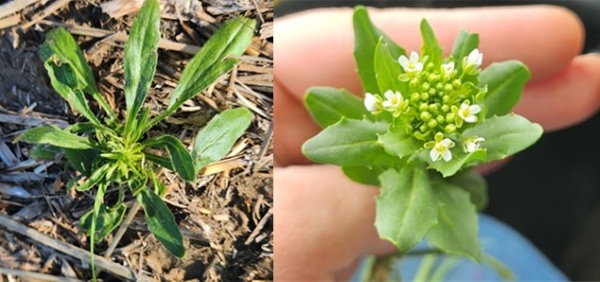
Additionally, two large and noticeable weeds—Canada thistle and milkweed—are about 8–12 inches tall as of last week. They’re most prominent along field edges, though we’ve also seen some newly planted fields with these weeds emerging throughout the field.
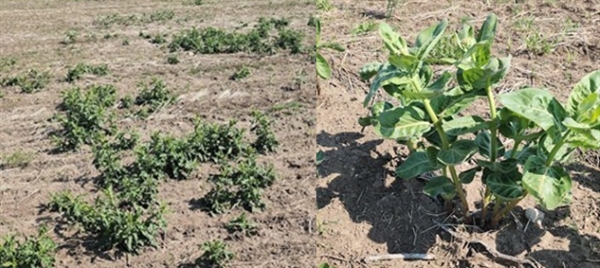
Sweep netting along field edges revealed grasshopper nymphs approximately 1 inch in length. I also found false chinch bugs, small insects that tend to congregate along field borders. These bugs overwinter in flixweed and are attracted to weedy areas due to the food source and favorable humid conditions. False chinch bugs are highly resistant to insecticides, but their presence is usually short- lived.
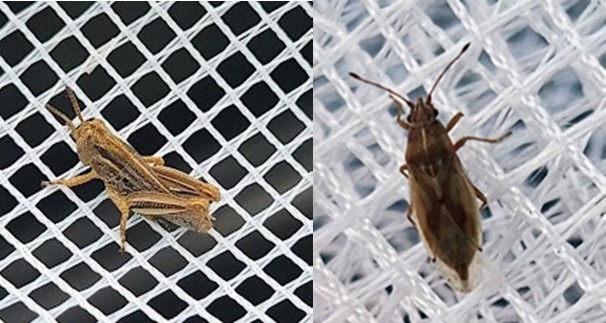
If you have any questions about your in crop application or would like us to scout your fields just reach out to the Fairview Agronomy location.
Julia Seiller, Fairview Location Agronomist
Zach Weiland, Fairview Location Agronomist & Future Manager
Weather Update
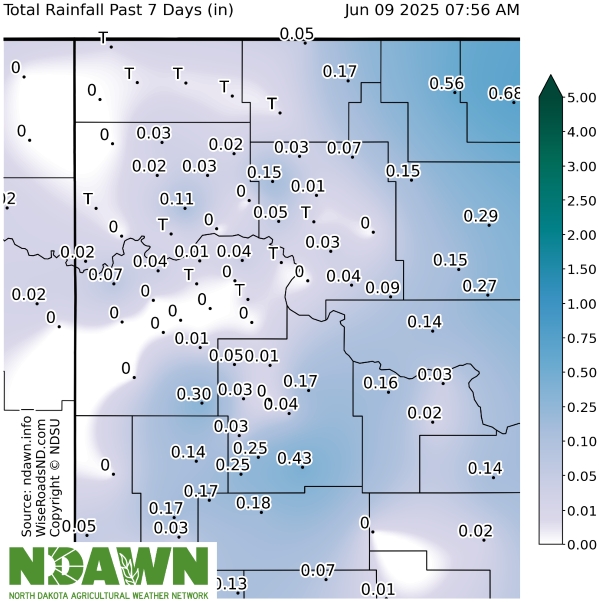
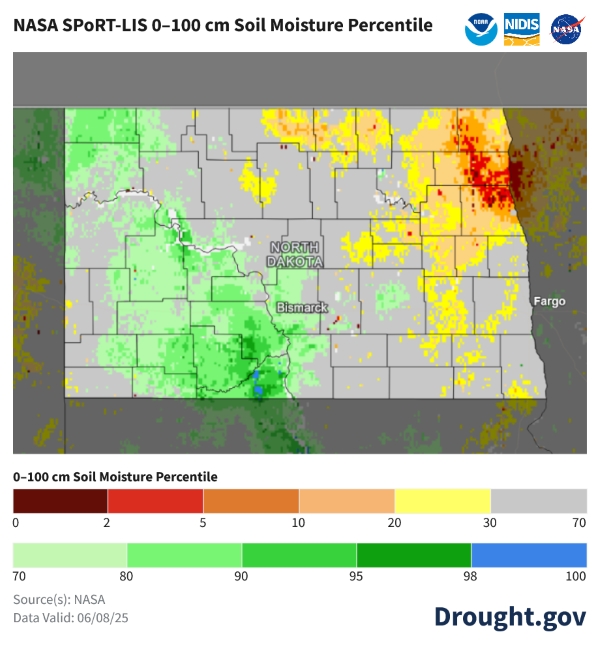
This map shows the soil moisture content of the top 100 cm compared to historical conditions (1981-2013). Red and orange colors indicate drier conditions, while green or blue indicate higher moisture levels.
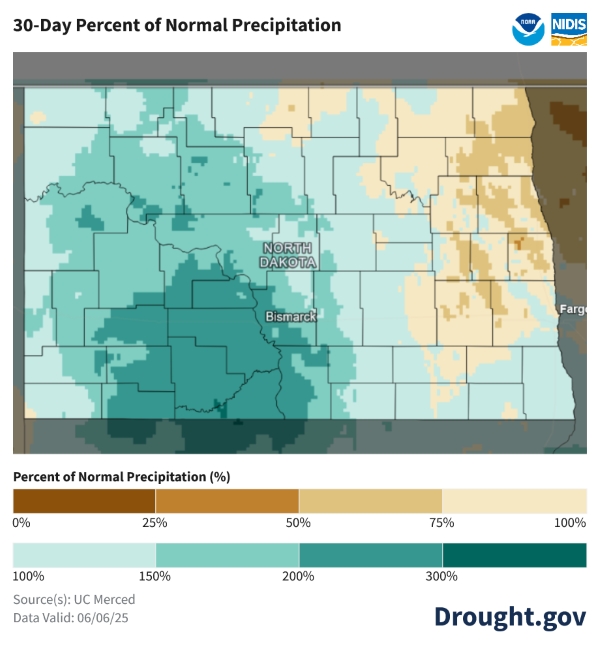
This map shows precipitation for the past 30 days as a percentage of the historical average (1991–2020) for the same time period. Green/ blue shades indicate above-normal precipitation, while brown shades indicate below-normal precipitation.

NDAWN Wheat Growing Degree Day Model output as of June 9th. Rainfall based on Williston NDAWN station